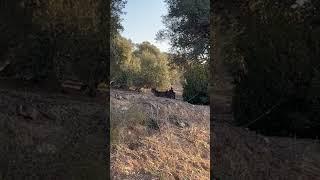Royal bengal tiger populations in continental Asia have been subsumed to P. t. tigris since the revision of felid taxonomy in 2017.[4]
Results of a genetic analysis of 32 tiger samples indicate that the Bengal tiger samples grouped into a different monophyletic clade than the Siberian tiger samples.[17
The Bengal tiger's coat is yellow to light orange, with stripes ranging from dark brown to black; the belly and the interior parts of the limbs are white, and the tail is orange with black rings. The white tiger is a recessive mutant, which is reported in the wild from time to time in Assam, Bengal, Bihar, and especially in the former State of Rewa. However, it is not an occurrence of albinism. In fact, there is only one fully authenticated case of a true albino tiger, and none of black tigers, with the possible exception of one dead specimen examined in Chittagong in 1846.Males and females have an average total length of 270 to 310 cm (110 to 120 in) and 240 to 265 cm (94 to 104 in) respectively, including a tail of 85 to 110 cm (33 to 43 in) long.[2][20] They typically range 90 to 110 cm (35 to 43 in) in height at the shoulders.[20] The standard weight of males ranges from 175 to 260 kg (386 to 573 lb), while that of the females ranges from 100 to 160 kg (220 to 350 lb).[2][20] The smallest recorded weights for Bengal tigers are from the Bangladesh Sundarbans, where adult females are 75 to 80 kg (165 to 176 lb).The tiger has exceptionally stout teeth. Its canines are 7.5 to 10 cm (3.0 to 3.9 in) long and thus the longest among all cats.The greatest length of its skull is 332 to 376 mm (13.1 to 14.8 in).
In Bangladesh, tigers are now relegated to the forests of the Sundarbans and the Chittagong Hill Tracts.[46] The Chittagong forest is contiguous with tiger habitat in India and Myanmar, but the tiger population is of unknown status.[47]As of 2004, population estimates in Bangladesh ranged from 200 to 419 individuals, most of them in the Sundarbans.[46] This region is the only mangrove habitat in this bioregion, where tigers survive, swimming between islands in the delta to hunt prey.[36] Bangladesh's Forest Department is raising mangrove plantations supplying forage for spotted deer. Since 2001, afforestation has continued on a small scale in the Sundarbans.[48] From October 2005 to January 2007, the first camera trap survey was conducted across six sites in the Bangladesh Sundarbans to estimate tiger population density. The average of these six sites provided an estimate of 3.7 tigers per 100 km2 (39 sq mi). Since the Bangladesh Sundarbans is an area of 5,770 km2 (2,230 sq mi), it was inferred that the total tiger population comprised approximately 200 individuals.[49] Home ranges of adult female tigers were recorded comprising between 12 and 14 km2 (4.6 and 5.4 sq mi), which would indicate an approximate carrying capacity of 150 adult females.[21][50] The small home range of adult female tigers and consequent high density of tigers in this habitat type relative to other areas may be related to both the high density of prey and the small size of the Sundarban tigers.[21]
Since 2007, tiger monitoring surveys have been carried out every year by WildTeam in the Bangladesh Sundarbans to monitor changes in the Bangladesh tiger population and assess the effectiveness of conservation actions. This survey measures changes in the frequency of tiger track sets along the sides of tidal waterways as an index of relative tiger abundance across the Sundarbans landscape.[51] By 2009, the tiger population in the Bangladesh Sundarbans was estimated as 100–150 adult females or 335–500 tigers overall. Female home ranges, recorded using Global Positioning System collars, were some of the smallest recorded for tigers, indicating that the Bangladesh Sundarbans could have one of the highest densities and largest populations of tigers anywhere in the world. They are isolated from the next tiger population by a distance of up to 300 km (190 mi). Information is lacking on many aspects of Sundarbans tiger ecology, including relative abundance, population status, spatial dynamics, habitat selection, life history characteristics, taxonomy, genetics, and disease. There is also no monitoring program in place to track changes in the tiger population over time, and therefore no way of measuring the response of the population to conservation activities or threats. Most studies have focused on the tiger-human conflict in the area, but two studies in the Sundarbans East Wildlife sanctuary documented habitat-use patterns of tigers, and abundances of tiger prey, and another study investigated tiger parasite load. Some major threats to tigers have been identified. The tigers living in the Sundarbans are threatened by habitat destruction, prey depletion, highly aggressive and rampant intraspecific competition, tiger-human conflict, and dire
Results of a genetic analysis of 32 tiger samples indicate that the Bengal tiger samples grouped into a different monophyletic clade than the Siberian tiger samples.[17
The Bengal tiger's coat is yellow to light orange, with stripes ranging from dark brown to black; the belly and the interior parts of the limbs are white, and the tail is orange with black rings. The white tiger is a recessive mutant, which is reported in the wild from time to time in Assam, Bengal, Bihar, and especially in the former State of Rewa. However, it is not an occurrence of albinism. In fact, there is only one fully authenticated case of a true albino tiger, and none of black tigers, with the possible exception of one dead specimen examined in Chittagong in 1846.Males and females have an average total length of 270 to 310 cm (110 to 120 in) and 240 to 265 cm (94 to 104 in) respectively, including a tail of 85 to 110 cm (33 to 43 in) long.[2][20] They typically range 90 to 110 cm (35 to 43 in) in height at the shoulders.[20] The standard weight of males ranges from 175 to 260 kg (386 to 573 lb), while that of the females ranges from 100 to 160 kg (220 to 350 lb).[2][20] The smallest recorded weights for Bengal tigers are from the Bangladesh Sundarbans, where adult females are 75 to 80 kg (165 to 176 lb).The tiger has exceptionally stout teeth. Its canines are 7.5 to 10 cm (3.0 to 3.9 in) long and thus the longest among all cats.The greatest length of its skull is 332 to 376 mm (13.1 to 14.8 in).
In Bangladesh, tigers are now relegated to the forests of the Sundarbans and the Chittagong Hill Tracts.[46] The Chittagong forest is contiguous with tiger habitat in India and Myanmar, but the tiger population is of unknown status.[47]As of 2004, population estimates in Bangladesh ranged from 200 to 419 individuals, most of them in the Sundarbans.[46] This region is the only mangrove habitat in this bioregion, where tigers survive, swimming between islands in the delta to hunt prey.[36] Bangladesh's Forest Department is raising mangrove plantations supplying forage for spotted deer. Since 2001, afforestation has continued on a small scale in the Sundarbans.[48] From October 2005 to January 2007, the first camera trap survey was conducted across six sites in the Bangladesh Sundarbans to estimate tiger population density. The average of these six sites provided an estimate of 3.7 tigers per 100 km2 (39 sq mi). Since the Bangladesh Sundarbans is an area of 5,770 km2 (2,230 sq mi), it was inferred that the total tiger population comprised approximately 200 individuals.[49] Home ranges of adult female tigers were recorded comprising between 12 and 14 km2 (4.6 and 5.4 sq mi), which would indicate an approximate carrying capacity of 150 adult females.[21][50] The small home range of adult female tigers and consequent high density of tigers in this habitat type relative to other areas may be related to both the high density of prey and the small size of the Sundarban tigers.[21]
Since 2007, tiger monitoring surveys have been carried out every year by WildTeam in the Bangladesh Sundarbans to monitor changes in the Bangladesh tiger population and assess the effectiveness of conservation actions. This survey measures changes in the frequency of tiger track sets along the sides of tidal waterways as an index of relative tiger abundance across the Sundarbans landscape.[51] By 2009, the tiger population in the Bangladesh Sundarbans was estimated as 100–150 adult females or 335–500 tigers overall. Female home ranges, recorded using Global Positioning System collars, were some of the smallest recorded for tigers, indicating that the Bangladesh Sundarbans could have one of the highest densities and largest populations of tigers anywhere in the world. They are isolated from the next tiger population by a distance of up to 300 km (190 mi). Information is lacking on many aspects of Sundarbans tiger ecology, including relative abundance, population status, spatial dynamics, habitat selection, life history characteristics, taxonomy, genetics, and disease. There is also no monitoring program in place to track changes in the tiger population over time, and therefore no way of measuring the response of the population to conservation activities or threats. Most studies have focused on the tiger-human conflict in the area, but two studies in the Sundarbans East Wildlife sanctuary documented habitat-use patterns of tigers, and abundances of tiger prey, and another study investigated tiger parasite load. Some major threats to tigers have been identified. The tigers living in the Sundarbans are threatened by habitat destruction, prey depletion, highly aggressive and rampant intraspecific competition, tiger-human conflict, and dire
- Catégories
- Chats de Race Bengal















Commentaires